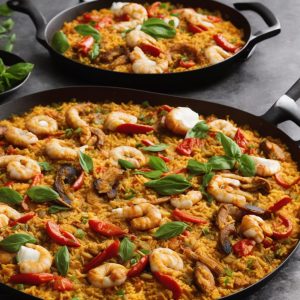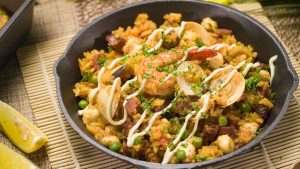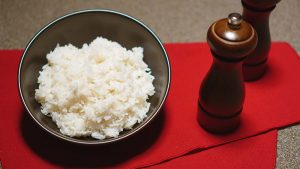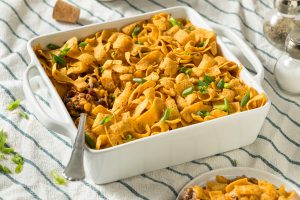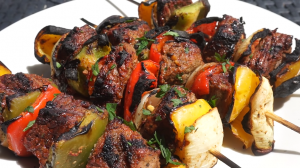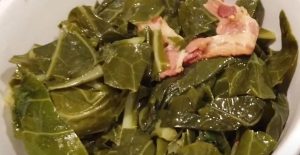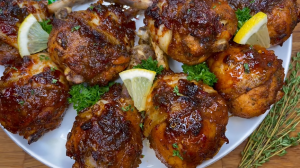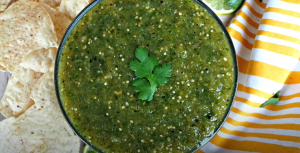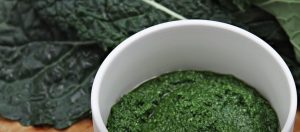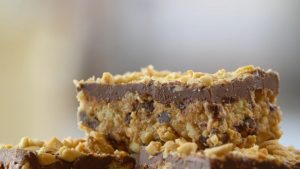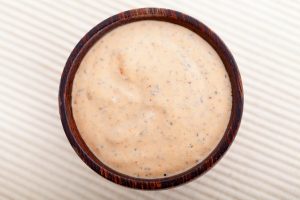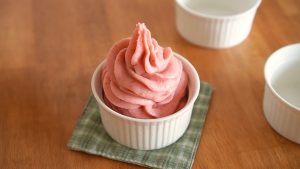Paella, a classic Spanish dish, is a flavorful combination of succulent seafood, tender chicken and vibrant vegetables. A feast for the senses, it is as much a treat to cook as it is to eat, bringing the warm, sunny flavors of Spain right to your kitchen.
Most of the ingredients for Paella are fairly common such as olive oil, onion, garlic, bell pepper, chicken fillets, tomatoes, white wine, salt, pepper and peas. But some ingredients like calamari rings, mussels, saffron powder, and medium grain rice may need a special trip to the supermarket. Make sure to look for saffron powder in the spice aisle, and you'll probably find the calamari rings and mussels in the frozen seafood section.
Ingredients for the Classic Spanish Paella
Olive oil: Used for sautéing and imparting a rich flavor.
Onion: To add a sweet and savory flavor.
Garlic: For a pungent kick.
Red bell pepper: Adds color and a sweet flavor.
Chicken thigh fillets: The protein that forms the base of the dish.
Tomatoes: They break down to form a sauce.
Dry white wine: Adds acidity and depth of flavor.
Salt and pepper: Seasoning to enhance all the flavors.
Mussels: Seafood that adds a taste of the sea.
Calamari rings: Another seafood ingredient that adds texture and flavor.
Chicken broth: The liquid in which the rice cooks.
Medium grain rice: The main carbohydrate, it cooks perfectly in the broth.
Frozen peas: Adds a pop of color and sweet flavor.
Saffron powder: A special spice that gives a unique aroma and golden color.
Paprika: Adds mild sweetness and color.
Garlic powder: For additional garlic flavor.
Onion powder: To add more onion flavor without extra moisture.
Shrimp: A juicy, succulent seafood addition.
Fresh flat leaf parsley: Garnish that adds a fresh, herby flavor.
Bell peppers: Used for garnish and extra flavor.
One reader, Florentia Obrien says:





This classic Spanish paella recipe is a game-changer! The flavors are rich and authentic, and the combination of seafood and chicken is simply divine. The saffron and paprika add a beautiful depth to the dish, making it a true showstopper. I can't wait to make it again!
Techniques Required for Making Classic Spanish Paella
How to sauté chicken: Sauté the chicken in a hot pan with a small amount of oil until it turns golden brown on all sides. This will help to seal in the juices and add flavor to the paella.
How to cook the rice: After adding the rice to the pan, bring the mixture to a boil, then reduce the heat and cover the pan. Allow the rice to absorb most of the liquid, stirring occasionally to prevent sticking and burning. Cook until the rice is almost tender.
How to cook the prawns: Add the prawns to the paella and mix them through the rice. Cover the pan and allow the prawns and rice to cook completely. This will ensure that the prawns are cooked to perfection and infused with the flavors of the dish.
How To Make Classic Spanish Paella
Make your dinner extra special by serving a delicious, classic Spanish dish. This Spanish paella recipe is loaded with fresh seafood and authentic flavors.
Serves:
Ingredients
- 2tbspolive oil
- 1largeonion,chopped
- 6largecloves garlic,finely chopped
- 1smallred bell pepper,diced into pieces (capsicum)
- 4largechicken thigh fillets,boneless, skinless, cut into bite-sized pieces
- 4largetomatoes,chopped
- ½cupdry white wine,(Sauv Blanc, Pinot Gris) optional
- Salt and pepper,to taste
- 12mussels,scraped and cleaned properly
- 8ozcalamari rings
- 3¾cupschicken broth,low sodium or stock, or homemade fish stock
- 2cupsmedium grain,or jasmine rice
- ½cupfrozen peas
- 1tspsaffron powder,or saffron threads
- 1tsppaprika,sweet or smoked
- ½tspgarlic powder
- ½tsponion powder
- 21ozshrimp
- 2tbspfresh flat leaf parsley,chopped
- bell peppers,fire roasted, capsicum, strips
Instructions
-
Heat oil in a large sized non-stick pan or well seasoned skillet (or a paella pan if you have one), over medium heat. Fry onion, garlic and capsicum together; cook for about 3 minutes until onion is transparent.
-
Sauté chicken until golden on all sides. Add in the chopped tomatoes, salt and pepper to taste. Cook for 5 minutes until they release liquid and the tomatoes begin to create a sauce.
-
Add the wine, mussels, and calamari rings. Allow to cook for a further 5 minutes. Allow the wine to evaporate to half the quantity, then pour in the stock (or broth), rice, peas and saffron. Mix all ingredients until well combined.
-
Bring to a boil. Reduce the heat and cover to allow most of the liquid to absorb into the rice, while stirring occasionally to prevent rice from sticking and burning to the pan underneath. Cook until the rice is almost cooked through.
-
Add in the prawns, mixing them through the rice, and cover again to allow the prawns and rice to cook completely.
-
Once cooked, sprinkle with the parsley. Place capsicum strips over the top of the paella for enhanced flavour when served. Drizzle with a small amount of olive oil over the top before serving.
Nutrition
- Calories: 653.24kcal
- Fat: 35.69g
- Saturated Fat: 9.00g
- Trans Fat: 0.15g
- Monounsaturated Fat: 15.76g
- Polyunsaturated Fat: 7.23g
- Carbohydrates: 21.61g
- Fiber: 3.26g
- Sugar: 7.52g
- Protein: 55.93g
- Cholesterol: 383.67mg
- Sodium: 1540.36mg
- Calcium: 132.29mg
- Potassium: 1193.22mg
- Iron: 4.18mg
- Vitamin A: 199.61µg
- Vitamin C: 41.54mg
Essential Technique Tip for Perfect Paella
When preparing your paella, it's crucial to not stir the rice too much once it starts cooking. This is because the goal is to create a crispy bottom layer, known as the 'socarrat'. This is considered a delicacy in Spanish cooking and is the sign of a well-cooked paella. So, resist the urge to stir and let the rice cook undisturbed for the best results.
Time-Saving Tips for Preparing Paella
Prep ahead: Chop and prepare all your ingredients in advance to streamline the cooking process.
Use a pre-made broth: Save time by using pre-made chicken broth instead of making it from scratch.
One-pot wonder: Consider using a large skillet or paella pan to cook everything in one pot, minimizing cleanup.
Frozen seafood: Opt for frozen seafood to save time on cleaning and preparing fresh seafood.
Multi-task: While the paella is cooking, use the time to clean and organize your kitchen to save time later.
Substitute Ingredients For Classic Spanish Paella Recipe
-
olive oil – Substitute with avocado oil: Avocado oil has a similar high smoke point and mild flavor, making it a suitable substitute for olive oil in paella.
-
onion – Substitute with shallots: Shallots have a milder and sweeter flavor compared to onions, adding a delicate taste to the paella.
-
garlic – Substitute with garlic paste: Garlic paste can be used as a convenient substitute for fresh garlic, providing the same flavor without the need for mincing.
-
red bell pepper – Substitute with yellow bell pepper: Yellow bell peppers offer a slightly sweeter flavor and vibrant color, complementing the dish just as well as red bell peppers.
-
chicken thigh fillets – Substitute with rabbit meat: Rabbit meat can be used as a lean and flavorful alternative to chicken in paella, adding a unique taste to the dish.
-
tomatoes – Substitute with canned diced tomatoes: Canned diced tomatoes can be used as a convenient substitute for fresh tomatoes, providing a consistent texture and flavor.
-
dry white wine – Substitute with chicken broth: Chicken broth can be used as a non-alcoholic substitute for white wine, adding depth of flavor to the paella.
-
mussels – Substitute with clams: Clams can be used as a substitute for mussels, offering a similar briny flavor and texture to the dish.
-
calamari rings – Substitute with octopus: Octopus can be used as a substitute for calamari, providing a tender and flavorful seafood element to the paella.
-
chicken broth – Substitute with vegetable broth: Vegetable broth can be used as a substitute for chicken broth, adding a rich and savory flavor to the paella.
-
medium grain rice – Substitute with Arborio rice: Arborio rice can be used as a substitute for medium grain rice, providing a creamy texture and excellent absorption of flavors.
-
frozen peas – Substitute with edamame: Edamame can be used as a substitute for peas, offering a similar pop of color and texture to the paella.
-
saffron powder – Substitute with turmeric: Turmeric can be used as a substitute for saffron powder, providing a vibrant color and earthy flavor to the dish.
-
paprika – Substitute with smoked paprika: Smoked paprika can be used as a substitute for paprika, adding a deep, smoky flavor to the paella.
-
garlic powder – Substitute with onion powder: Onion powder can be used as a substitute for garlic powder, providing a milder and sweet flavor to the dish.
-
onion powder – Substitute with garlic powder: Garlic powder can be used as a substitute for onion powder, adding a savory and aromatic flavor to the paella.
-
shrimp – Substitute with lobster tail: Lobster tail can be used as a luxurious substitute for shrimp, adding a rich and sweet flavor to the paella.
-
flat leaf parsley – Substitute with cilantro: Cilantro can be used as a substitute for flat leaf parsley, providing a fresh and herbaceous flavor to the dish.
-
bell peppers – Substitute with pimentos: Pimentos can be used as a substitute for bell peppers, offering a sweet and mild flavor to the paella.
Best Way to Present Classic Spanish Paella
-
Elevate the paella with a stunning presentation: When plating the paella, consider using a traditional paella pan to showcase the dish's authenticity and heritage. The vibrant colors of the ingredients should be the star of the show, so arrange them artfully and ensure the rice is evenly spread across the pan.
-
Garnish with fresh herbs: Sprinkle the paella with freshly chopped flat-leaf parsley to add a pop of color and a burst of fresh flavor. The green hues will contrast beautifully with the rich, golden tones of the paella, creating an eye-catching presentation.
-
Incorporate edible flowers for a touch of elegance: Introduce delicate, edible flowers such as saffron blossoms or pansies to add a touch of elegance to the dish. These floral accents will not only enhance the visual appeal but also provide a subtle, aromatic essence.
-
Highlight the seafood: Arrange the mussels, calamari rings, and shrimp strategically on top of the paella, ensuring they are prominently displayed. This will emphasize the premium quality of the seafood and create a visually appealing focal point.
-
Create a colorful bell pepper garnish: Slice vibrant bell peppers into thin strips and arrange them in a visually appealing pattern on top of the paella. The bright, contrasting colors will add visual interest and a touch of sweetness to the dish.
-
Drizzle with a swirl of high-quality olive oil: Just before serving, add a drizzle of olive oil in a graceful, swirling motion across the paella. This final touch not only enhances the flavors but also adds a glossy sheen to the dish, elevating its overall presentation.
Essential Tools for Making Paella
- Cutting board: A flat, sturdy surface for chopping and preparing ingredients.
- Chef's knife: A versatile, multipurpose knife for slicing, dicing, and chopping.
- Paella pan: A wide, shallow pan with handles, specifically designed for cooking paella.
- Wooden spoon: Ideal for stirring and mixing ingredients in the paella.
- Measuring cups and spoons: For accurately measuring out ingredients.
- Large non-stick skillet: Can be used as an alternative to a paella pan for cooking the dish.
- Spatula: Useful for flipping and turning ingredients while cooking.
- Grater: For grating tomatoes or other ingredients as needed.
- Tongs: Handy for handling and turning the chicken, seafood, and other ingredients.
- Lid or foil: To cover the paella while cooking and allow the rice to steam and absorb the flavors.
How To Store and Freeze Leftover Paella
-
Let the paella cool completely before storing it in the refrigerator. This will prevent the rice from becoming mushy and the flavors from becoming muddled.
-
Once cooled, transfer the paella to an airtight container or cover the pan tightly with plastic wrap. Store in the refrigerator for up to 3-4 days.
-
To reheat, sprinkle a little water or chicken broth over the top of the paella and cover with a lid or foil. Heat in a 350°F (175°C) oven until warmed through, about 15-20 minutes. Alternatively, you can reheat individual portions in the microwave, stirring occasionally, until heated through.
-
If you have leftovers that you won't be able to eat within 3-4 days, you can freeze the paella for longer storage. Transfer the cooled paella to a freezer-safe container or resealable plastic bag, removing as much air as possible before sealing.
-
Label the container or bag with the date and contents, and freeze for up to 2-3 months. When ready to eat, thaw the paella in the refrigerator overnight.
-
To reheat frozen paella, place it in a covered dish and heat in a 350°F (175°C) oven until warmed through, about 20-30 minutes. You may need to add a little extra chicken broth or water to prevent the rice from drying out during reheating.
-
Keep in mind that the texture of the seafood and vegetables may change slightly after freezing and reheating, but the overall flavor of the dish should remain delicious.
How To Reheat Leftover Paella
Here are the best methods for reheating leftover classic spanish paella recipe:
-
Stovetop method: Place the leftover paella in a large skillet or paella pan over medium-low heat. Add a splash of chicken broth or water to help moisten the rice and prevent it from drying out. Stir gently to distribute the liquid and heat the paella evenly. Cover the pan and let it simmer for 5-10 minutes, or until the paella is heated through and the rice is tender. If the paella seems too dry, add a bit more liquid as needed.
-
Oven method: Preheat your oven to 350°F (175°C). Transfer the leftover paella to an oven-safe dish and cover it with aluminum foil. Place the dish in the preheated oven and bake for 15-20 minutes, or until the paella is heated through and the rice is tender. If the paella seems dry, you can add a splash of chicken broth or water before covering it with foil.
-
Microwave method: While not ideal, you can reheat paella in the microwave if you're short on time. Transfer the leftover paella to a microwave-safe dish and cover it with a damp paper towel. Microwave on high power in 1-minute intervals, stirring between each interval, until the paella is heated through and the rice is tender. Be careful not to overcook the shrimp and other seafood, as they can become rubbery when reheated in the microwave.
-
Regardless of the reheating method you choose, be sure to reheat the paella until it reaches an internal temperature of 165°F (74°C) to ensure food safety. If the paella has been stored in the refrigerator for more than 3-4 days, it's best to discard it to avoid the risk of foodborne illness.
-
To add extra flavor and moisture to your reheated paella, consider garnishing it with fresh lemon wedges, chopped parsley, or a drizzle of olive oil before serving.
Random Fact About Paella
The classic Spanish paella recipe is a traditional dish originating from Valencia, Spain. It typically includes a combination of chicken, seafood, and rice, flavored with saffron and other spices. The dish is often cooked in a wide, shallow pan called a paellera, which allows the rice to cook evenly and develop a delicious crust on the bottom known as socarrat. This iconic dish is a symbol of Spanish cuisine and is enjoyed by people around the world for its rich flavors and vibrant colors.
Is Making Paella at Home Economical?
The classic Spanish paella recipe is moderately cost-effective for a household. The combination of chicken, seafood, and rice makes it a hearty and satisfying meal. The cost for a household of 4 people is approximately $35-$40, depending on the availability and prices of seafood and chicken. The rich flavors and variety of ingredients make it a worthwhile investment for a special family dinner. Overall Verdict: 8/10
Is Paella Healthy or Unhealthy?
The classic Spanish paella recipe is a delicious and well-balanced dish that incorporates a variety of healthy ingredients. The recipe includes lean protein sources such as chicken, shrimp, mussels, and calamari, which are all low in fat and high in essential nutrients. The dish also features a generous amount of vegetables, including onions, garlic, bell peppers, tomatoes, and peas, which provide fiber, vitamins, and minerals. The use of olive oil as the primary cooking fat adds heart-healthy monounsaturated fats to the dish.
However, there are a few aspects of the recipe that could be improved to make it even healthier:
- Reduce the amount of olive oil used in the recipe to lower the overall calorie and fat content
- Use low-sodium chicken broth to decrease the dish's salt content
- Increase the proportion of vegetables to rice and protein to boost the fiber and nutrient content
- Opt for whole-grain rice instead of medium-grain rice to increase the dish's fiber and complex carbohydrate content
- Limit the consumption of paella to moderate portion sizes, as it can be calorie-dense due to the rice and protein components
Editor's Thoughts on This Classic Spanish Dish
The classic Spanish paella recipe you've provided is a delightful combination of flavors and textures. The use of saffron, paprika, and a variety of seafood and meats creates a rich and aromatic dish. The step-by-step instructions are clear and easy to follow, ensuring a successful outcome. However, I would recommend adding a touch of acidity, such as a squeeze of lemon juice, to brighten the flavors. Overall, this recipe promises to deliver a delicious and authentic Spanish dining experience.
Enhance Your Classic Spanish Paella Recipe with These Unique Side Dishes:
Similar Recipes to Classic Spanish Paella
Appetizers and Desserts to Complement Classic Spanish Paella
Why trust this Classic Spanish Paella Recipe:
This authentic Spanish paella recipe is a culinary journey to the heart of Spain. With traditional ingredients like saffron, fresh seafood, and aromatic spices, this recipe captures the essence of Spanish cuisine. The step-by-step instructions ensure a flavorful and visually stunning dish that will transport you to the bustling streets of Valencia. Trust in the rich history and cultural significance of paella, and let this recipe guide you to create a memorable dining experience that celebrates the vibrant flavors of Spanish cuisine.
Was this page helpful?
Have your own special recipe to share? Submit Your Recipe Today!




